duet
-
Mozart – Sonata in E minor – Clarinet (and Piano)
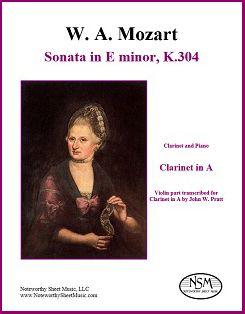 Sonata in E minor, K.304, by W. A. Mozart
Sonata in E minor, K.304, by W. A. MozartTranscribed for Clarinet (and Piano) by John W. Pratt
Clarinet in A Part, PDF $5.99
Mozart's second group of violin sonatas, the seven "Mannheim" sonatas of 1778, were begun in Mannheim where the composer also worked on a flute commission. The violin parts rarely make significant use of double stops and are in general well suited to a wind instrument. Mozart's works in minor keys are rare and special: consider the G-minor quintet and Symphony No. 40. The K.304 sonata is his only work in E minor and it is mysteriously compelling in its simplicity. Mr. Pratt has created an excellent transcription of the Sonata in E minor, K.304 for A-clarinet. K.304 was written the same summer that Mozart's mother died, an association often pointed to and the inspiration for our cover image selection.Note that Mr. Pratt's transcription offers the advantage of being in the original key, and that we provide the A-clarinet part only. The clarinet part works perfectly with the piano part in Mozart's score for piano and violin, which is in the public domain and readily available on imslp.org, free of charge.
For additional information about the seven Mozart Mannheim sonatas and Mr. Pratt's previous transcriptions of them for alto flute, please read his article Mozart's Mannheim Sonatas, which was originally published by Flute Focus and subsequently republished by NSM on our Resources – Reviews and Articles page.
Preview
Clarinet part, 5 pages; Total, 8 pages. -
Nelson - Play of Light - Flute & Harp
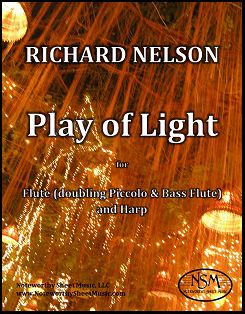 Play of Light, by Richard Nelson
Play of Light, by Richard Nelson Contemporary Composition for Flute (doubling piccolo & bass flute) and Harp
Score and Flute Part, PDF $15.25
Play of Light, for flute and harp, was written for the duo "2" (Peter H. Bloom and Mary Jane Rupert). The piece is built around spaciousness, transparency, multi-hued shadings and playful chases. The incorporation of bass flute and piccolo further enhances the inherently rich color possibilities of the flute/harp combination—the three flute instruments in succession form a sort of "super-flute" in the work's final section.
Drawing on his jazz and improvisation background, composer Richard Nelson in this composition leads the players into a substantial section that they complete through improvisation. While they follow signposts on intensity, energy and pitch content that he provides, this practice nonetheless creates an element of intrigue and unpredictability that the composer values highly. It also assures that each performance of the piece will have a strongly individual profile.
The Duo "2" artists have released a studio recording ofPlay of Light, available free of charge; please click the link to listen to the audio file on the composer's SoundCloud site.
Peter H. Bloom gave a lecture on “Effective Writing for Flutes and the Contemporary Flutist” at the 2018 Snow Pond Composers Workshop. In his presentation, Mr. Bloom discussed various topics using four contemporary works published by Noteworthy Sheet Music, including Play of Light, as examples. We later published a free text version of this excellent presentation on our website, in the Reviews and Articles section, including some of the audio clips and supplemental written materials that Mr. Bloom used as demonstrations.
Score, 23 pages; Flute part, 9 pages; Total, 36 pages.
Preview==========================================================
We also offer a print version of Play of Light by Richard Nelson, for those who prefer to purchase the work as a professionally-printed hard copy. Due to prohibitively high international shipping rates, we ship print editions only to addresses in the USA. The cost of the hard copy edition of Play of Light is $25.93, plus a $5.95 shipping and handling fee. Please use the Contact Us form to let us know which print publication(s) you would like to purchase, along with your email contact information and USPS mailing address. We will then send you a PayPal invoice for the sale and, once we receive notice from PayPal that you have paid for the item(s), we will ship your music to the address provided for delivery in 7-10 business days. -
Nicholson - Coolun - Fl or Fl & Pf or Fl & Hp
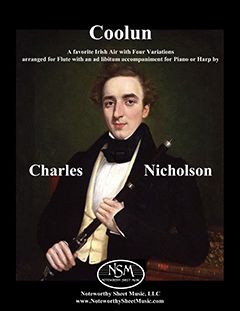 Coolun, A favorite Irish Air with Four Variations, by C. Nicholson
Coolun, A favorite Irish Air with Four Variations, by C. NicholsonGassett Collection - Facsimile Edition by C.A.Vater/Noteworthy Sheet Music
Piano Score and Flute Part, PDF $9.99
Charles Nicholson (1795-1837) was a masterful, hugely popular, and highly influential English flutist and teacher, famous for his individual style and powerful tone. Among Nicholson's compositions are 13 fantasies and 15 airs with variations, including Coolun. A favorite Irish Air with Four Variations arranged for the Flute with an ad libitum Accompaniment for the Piano Forte, or Harp. The "Coulin" or "Coolan" was described in an 1833 letter to the editor of the Dublin Penny Journal (www.libraryireland.com) as "an air, that once heard even in the earliest infancy, can never be forgotten—a melody which breathes the most touching tenderness and exquisite sensibility, and the memory of which, enables the Irish to hear Scotland's 'O, Nanny wilt thou gang with me,'—or her 'Banks and Braes,' without envious repinings."
Nicholson's consummate rendition of Coolun is highly effective when played either as a solo for flute alone or by flute with accompaniment of piano, lever harp, or pedal harp. The Gassett Collection print from which our facsimile was created consists of a score for piano forte and flute, without a separate flute part. The flute part included in our edition was created from the score using a modern music notation software program.
Noteworthy Sheet Music's publication of Coolun was favorably reviewed by Katherine Borst Jones in the January, 2014 issue of Flute Talk magazine. You can read the review, reproduced on our website for your convenience, or at Flute Talk (subscribers).
For additional information about the Gassett Collection, please see see our article An Introduction to the Gassett Collection.
Piano score, 6 pages; Flute part, 5 pages; Total, 15 pages.
Preview
==============================================================================
To order our print edition of Coolun, A Favorite Irish Air arranged for Flute and Piano or Harp for $16.98 plus a $5.95 shipping and handling fee to addresses in the USA. Use the Contact Us form to let us know which hard copy publication(s) you would like to purchase, along with your email contact information and USPS mailing address. We will then send you a PayPal invoice for the sale and, once we receive notice from PayPal that you have paid for the item(s), we will ship your music to the address provided.
-
Nielsen - Fantasy Pieces - Alto Flute & Piano
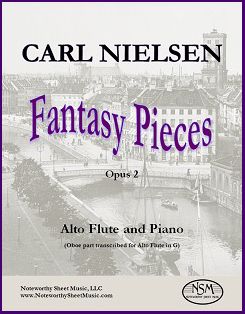 Fantasy Pieces, Op.2, by Carl Nielsen
Fantasy Pieces, Op.2, by Carl NielsenTranscribed for Alto Flute by C.A.Vater
Piano Score and Alto Flute Part, PDF $9.99
The Fantasy Pieces for Oboe and Piano, Op.2 (Fantasistykker for obo og klavier) were composed in 1889, when Nielsen was 24. They were written in the romantic idiom before his compositions became more experimental, chromatic, and dissonant. Nielsen wrote the Fantasy Pieces for his good friend Olivo Kraüse, the Danish oboist and composer to whom the work is dedicated. Nielsen and Krause were colleagues in the Royal Chapel Orchestra. The Fantasy Pieces were premiered by Krause and the pianist Victor Bendix at a Royal Orchestra Soirée in Copenhagen in 1891. Arrangements of the pieces for violin (with orchestra or piano), created by Hans Sitt, subsequently became quite popular.
Our transcription of the oboe part for alto flute is a simple transposition, as the entire oboe part falls nicely within the range of the alto flute. Although the tonal characteristics of the alto flute and oboe are very different, the Fantasistykker sound so natural on alto flute that the listener might think that the two pieces were composed specifically for that instrument.
The first piece, Romance, is a beautiful andante that allows the alto flutist to exploit the rich, sensuous sonority of the instrument. The contrasting second piece is a lively Humoresque in which the performer's lightheartedness and technical agility prevail.
Alto Flute part, 3 pages; Piano Score, 10 pages; Total, 18 pages.
Preview -
Pierné - Canzonetta - Alto Flute & Piano
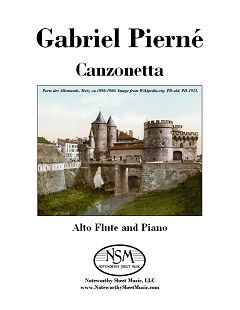 Canzonetta, Op.19, by G. Pierné
Canzonetta, Op.19, by G. PiernéTranscribed for Alto Flute and Piano by C.A.Vater
Piano Score and Alto Flute Part, PDF $6.99
Gabriel Pierné composed his Canzonetta for clarinet and piano (Op.19) in 1888, and it is among his most charming lighter works. The number of commercial recordings of the piece attest to its enduring popularity, extending into the modern era. Pierné dedicated this short, cheerful little song to his friend Charles Turban (1845-1905), the French clarinetist and professor of clarinet at the Paris Conservatory. The main melody is bouncy and gay, and brings merriment to players and audiences alike. Others have created transcriptions for alto sax and for flute. The piece is just as delightful when played on alto flute, and we now offer our new edition for alto flute and piano. Canzonetta would make a great encore piece for a concert or recital.
Alto Flute Part, 2 pages; Piano Score, 5 pages; Total, 10 pages.
Preview -
Pierné - Pièce - Alto Flute & Piano
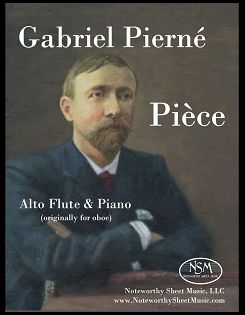 Pièce, Op.5, by Gabriel Pierné
Pièce, Op.5, by Gabriel Pierné Transcribed for Alto Flute and Piano by Carol A. Vater
Piano Score and Alto Flute Part, PDF $6.99
The Pièce en sol mineur for oboe (or violin or cello) with accompaniment of piano was composed by Gabriel Pierné in 1883. The alto flute is especially well-suited to this delightful, romantic piece, which falls completely and comfortably within the alto flute's range. Our edition includes both the alto flute part and the piano score.
Piano score, 5 pages; Alto Flute part, 2 pages; Total, 12 pages.
Preview -
Popp - Greetings to Hungary - Flute and Piano
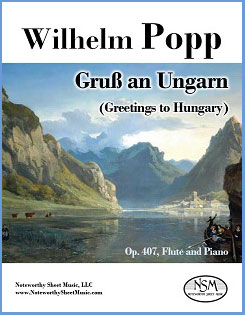 Greetings to Hungary, Op.407, by Wilhelm Popp
Greetings to Hungary, Op.407, by Wilhelm PoppFlute and Piano
Flute Part and Piano Score, PDF $0.00
Wilhelm Albrecht Otto Popp (1828-1903) was an esteemed German composer, flutist, and pianist. He received his flute training from Caspar Kummer and Louis Drouet, and served as court pianist and flutist at the Ducal Saxon Court Theater in Coburg-Gotha. In 1867 he moved to Hamburg and became first flute of the Hamburg Philharmonic Orchestra. Popp composed some 600 works, many of which were written for flute and piano; most of his compositions were published in his lifetime and were well-known to musicians of his day.
Wilhelm Popp’s Gruß an Ungarn (Greetings to Hungary) was first published for flute and orchestra in 1890, and an edition for flute and piano was published in 1899. NSM re-notated the flute and piano version, changing only the formatting and adding bar numbers and a new cover page. With a decidedly Hungarian sentiment, this piece is great fun to play and provides an enjoyable, exciting listen for audiences as well.
Click for a free download of our re-typeset edition of Popp’s Gruß an Ungarn.
Piano score, 8 pages; Flute part, 5 pages; Total 16 pages.
-
Reger - Albumblatt - Alto Flute & Piano
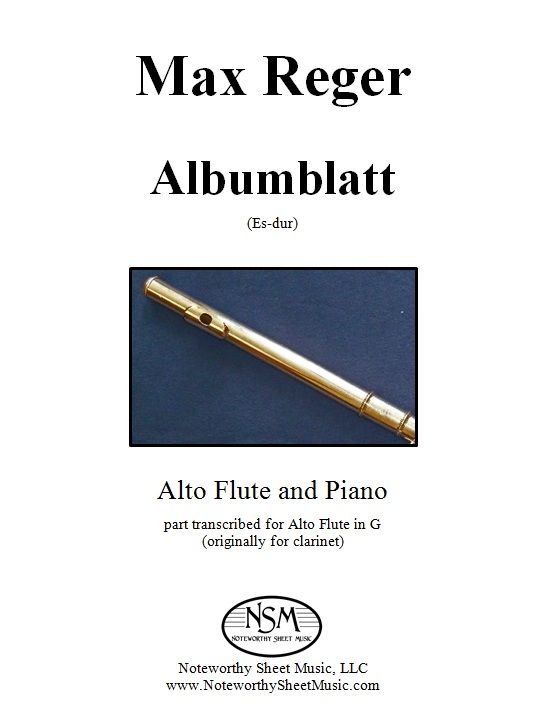 Albumblatt, by Max Reger
Albumblatt, by Max RegerTranscribed for Alto Flute and Piano by Carol A. Vater
Piano Score and Alto Flute Part, PDF $3.97
This gorgeous and surprisingly complex Albumblatt in E-flat major was written by Max Reger in ~1902 and originally scored for clarinet and piano. The piece is beautifully-suited to the range and sonority of the alto flute, and we provide here both our alto flute transcription of the clarinet part and a re-notated edition of the piano score.
Piano score, 2 pages; Alto Flute part, 1 page; Total, 5 pages.
-
Reger - Romanze - Alto Flute and Piano
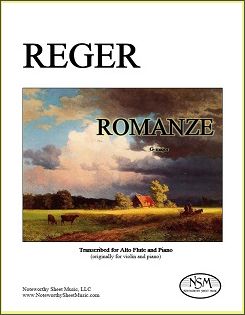 Romanze, by Max Reger
Romanze, by Max RegerTranscribed for Alto Flute in G and Piano by C.A.Vater
Alto Flute Part and Piano Score, PDF $4.99
Reger's Romanze is a lovely, short piece in G major, consisting of a single movement, Andante con moto. Written in 1902 for violin (or cello) and piano, the work was published by Breitkopf und Härtel ca.1920 and is now in the public domain. Numerous arrangements and transcriptions of the Romanze, including those for C-flute, trumpet, cello, clarinet, viola, or alto saxophone and piano, and even one for oboe and accordion, attest to the piece's popularity. The Romanze works beautifully on alto flute, and Noteworthy Sheet Music's 2016 edition includes both our transcribed alto flute part and a re-notated piano score.
Cover image courtesy of Wikimedia Commons, PD-old: "Bavarian Landscape", by Albert Bierstadt (1830–1902).
Alto Flute Part, 1 page; Score 2 pages; Total, 6 pages.
Preview -
Reger - Suite in A Minor - Alto Flute
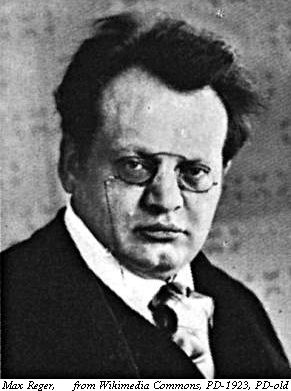 Suite in A Minor, Op.103a, by Max Reger
Suite in A Minor, Op.103a, by Max RegerTranscribed for Alto Flute and Piano by Carol A. Vater
Alto Flute Part, PDF $11.98
The Suite in A Minor for violin and piano by Max Reger was first published in 1908. The piece has been performed and recorded on flute, and arrangements of the beautiful Aria (3rd movement) have been published for violin and orchestra, as well as for cello and piano or organ. The piece is also highly suited to the rich, mellow sonorities of the alto flute. We offer here our transcription of all six movements of the violin part for alto flute. The piano part is readily available in the public domain as a free pdf download of the score for violin and piano. Here is a link to one such source: Piano Score
Alto Flute part, 12 pages; Total, 14 pages.
Preview -
Reissiger & Fürstenau - Les Inseparables! - Fl & Pf
 Les Inseparables!, Op.45, by Reissiger & Fürstenau
Les Inseparables!, Op.45, by Reissiger & FürstenauGrand Original Duets for Piano and Flute, No.1
Gassett Collection - Facsimile Edition by C.A.Vater/Noteworthy Sheet Music
Flute and Piano Parts, PDF $20.25
Carl Gottlieb Reissiger's Opus 45 was written as a Sonata for Violin and Piano, but was adapted for flute by Anton Bernhard Fürstenau. Fürstenau (1792-1852) composed and arranged many works for flute. He was among the most admired flutists of the 19th century and remains a well-known favorite of flutists today. Reissiger (1798-1859) was an accomplished composer of opera, orchestral, and chamber music. An influential figure in the city of Dresden, he served as Director of the Dresden Opera and later as Kapellmeister. Les Inseparables! No.1, is the first of the Three Grand Original Duets for Piano and Flute by Reissiger and Fürstenau. The piece, which consists of three movements, is a virtuosic work that should delight and challenge both players.
For additional information about the Gassett Collection, please see see our article An Introduction to the Gassett Collection.
Piano part, 21 pages; Flute part, 6 pages; Total, 33 pages.
Preview -
Reissiger & Sedlatzek - La Pasta - Fl & Pf
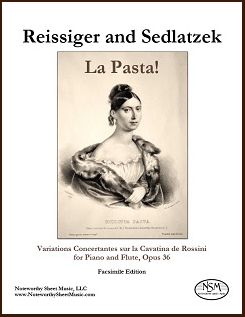 La Pasta! Op.36, by Reissiger & Sedlatzek
La Pasta! Op.36, by Reissiger & SedlatzekConcertantes Variations sur la Cavatina de Rossini, No.3
Gassett Collection - Facsimile Edition by C.A.Vater/Noteworthy Sheet Music, with a Foreword by Peter H. Bloom
Flute and Piano Parts, PDF $13.50
Reissiger and Sedlatzek's work La Pasta is a particularly effective concert piece with which the accomplished flutist can enthrall a diverse audience by evoking the dramatic majesty of grand opera while applying the scintillating techniques of the 19th century virtuoso. La Pasta is flutist Johann Sedlatzek's homage, celebration, and souvenir of the redoubtable mezzo-soprano Giuditta Pasta (1798± - 1866±), arranged by the superb composer/conductor Carl Gottlieb Reissiger. Pasta (nee Negri) was a cynosure of Italian opera who created brilliant dramatic roles for Bellini, Donizetti, and Rossini. Legendary Maria Callas (1923-77) is often compared to Pasta by opera aficionados, but few are likely to have heard both in their prime. — P. H. Bloom, 5/23/2011
For additional information about the Gassett Collection, please see see our article An Introduction to the Gassett Collection.
Piano part, 13 pages; Flute part, 5 pages; Total, 24 pages
Preview
-
Robichaux - Recurrence - Flute & Piano
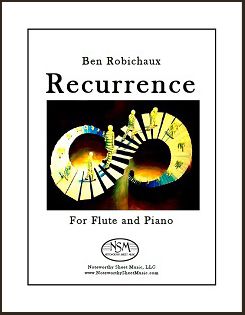 Recurrence, by Ben Robichaux
Recurrence, by Ben RobichauxContemporary Composition for Flute and Piano
Flute Part and Piano Score, PDF $12.99
NSM welcomed composer Ben Robichaux as a new contributor to our catalog in early June, 2017, when we published his piece Recurrence for flute and piano. For details of Mr. Robichaux's background, interests, and other works, please click the link to access the Composers section of the NSM website.
Recurrence was written for the composer's friend Michael Lyons. As outlined in the program notes, the "duet is framed in a traditional rondo form: ABACA. The returns of the A theme are never literal returns and repeated materials among the differing sections are never identical repetitions. These returns of A are the inspiration for the title, and the re-occurrence of the A material is a study on the lengths that a theme can be stretched and still be recognizable. The returns undergo extensive development. The B and C sections are meant to be extreme contrasts to the A sections as a means of cleansing the aural palate in order to erase the listener's memory of the theme. Despite the great lengths taken to blur the primary theme, its recognizability is undeniable. The closing section is a reflection on the basic differences among the three occurrences of the main theme. This final section is a summation of the processes that have previously been blurred by the contrasting sections of the piece. Ultimately the form portrays a futile fight that concludes with a peaceful resignation to the inevitable."
 The premiere of Recurrence took place in July, 2017, with Kenneth Cox (flute) and Bronwyn Schuman (piano). The performance was recorded by audio engineer Charles Hagaman; a sample can be heard by clicking the mp3 icon.
The premiere of Recurrence took place in July, 2017, with Kenneth Cox (flute) and Bronwyn Schuman (piano). The performance was recorded by audio engineer Charles Hagaman; a sample can be heard by clicking the mp3 icon. The cover artwork for our publication was created by Scoop Brancisco, used with permission.
Piano score, 10 pages; Flute part, 3 pages; Total, 15 pages.
Preview -
Saint-Saëns - Fantaisie - Flute
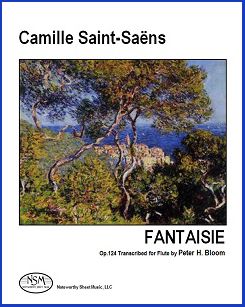 Fantaisie, Op.124, by Camille Saint-Saëns
Fantaisie, Op.124, by Camille Saint-SaënsTranscribed for Flute (originally for violin) by Peter H. Bloom
Flute Part, PDF $8.98
The following excerpt is taken from Peter H. Bloom's foreword to the edition:
"We flutists are always on the lookout for great repertoire to perform with harp, and the Fantaisie is a perfect gem to purloin from the violinists' repertoire. The expressively romantic melodies, lush impressionistic sonorities, athletic intervals, diversity of articulation, variety of dynamics, and evocative exoticism are ideal for the flute. The few problems of range are easily modified, customized, accommodated. As a duo, the work features both instruments in equally prominent and demanding roles. It's no surprise, then, that a number of flute transcriptions have been generated over the years. My goal, in this current work, is to provide fellow flutists with a significantly fresh approach to the Fantaisie.
Although a simplified adaptation of the Fantaisie is fairly straightforward, an arrangement that preserves the thrilling virtuosic intensity and rhetorical thrust of the work is another matter. An accurate presentation of Saint-Saëns's aural palette is essential to an authentic performance of the Fantaisie, and methods of achieving dynamic balance and tonal color often differ between flute and violin. The rhetorical nuances of articulation between the two instruments also require different approaches to achieve equivalent interpretations. The treatment of the violin pizzicato at measure 178, the elimination of articulation marks at measure 11, the inversions of double-stops/tremolos at measure 43-44 and 77-86, and the octave transposition from measure 184-194 exemplify these accommodations.
Violin double-stops present a conundrum. Technically impossible on the flute, double-stops are often reduced to a single line. The lower part is simply excised. But discarding the sonic complexity and virtuosic gesture of Saint-Saëns's parallel voicing dilutes the music and belies the composer's dramatic intentions. I've suggested double-stops be executed, on the flute, as tremolos. They're somewhat challenging but not impossible. Consider that the tremolo, as a virtuoso flute technique, was perhaps more popular during the composer's lifetime than in the late 20th and early 21st centuries.
Changes to the original violin part are made, here, with the intention of conserving the composer's ingenious creation. After a decade of study, experimentation, adjustment, and performance of this work, I've settled on a transcription for flute that conveys, with integrity, the musical spirit of the original orchestration."
P. H. Bloom, May 11, 2013 ©
 Click the icon to listen to a portion of the Saint-Saëns's Fantaisie performed by the duo "2", Peter H. Bloom on flute and Mary Jane Rupert on harp. Or watch part of a performance video on YouTube.
Click the icon to listen to a portion of the Saint-Saëns's Fantaisie performed by the duo "2", Peter H. Bloom on flute and Mary Jane Rupert on harp. Or watch part of a performance video on YouTube. Fantaisie, Op.124 was written originally for violin and harp. We provide the Fantaisie flute part transcribed by P. H. Bloom; the harp part is available as a free PDF download from online libraries of public domain music, such as imslp.org.
Flute part, 7 pages; Total, 12 pages.
Preview
========================================================
We also offer a professionally-printed hard copy edition of Fantaisie, Op.124 by Saint-Saëns, transcribed for Flute for $14.99 plus a $5.95 shipping and handling fee to addresses in the USA. Use the Contact Us form to let us know which hard copy publication(s) you would like to purchase, along with your email contact information and USPS mailing address. We will then send you a PayPal invoice for the sale and, once we receive notice from PayPal that you have paid for the item(s), we will ship your music to the address provided.
-
Saint-Saëns - Sonata - Alto Flute
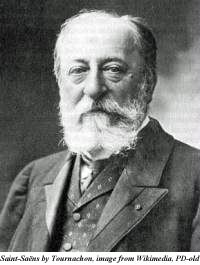 Sonata, Op.166, by Camille Saint-Saëns
Sonata, Op.166, by Camille Saint-SaënsTranscribed for Alto Flute and Piano by C.A.Vater and J.W.Pratt
Alto Flute Part, PDF $6.99
Sonata, Opus 166 (Oboe Sonata in D major) was composed by Saint-Saëns in 1921, the year of his death, and has since become a standard of the oboe repertoire. Although written for oboe with accompaniment of piano, the piece is very well suited for alto flute. Played by either oboe or alto flute, this Sonata provides the soloist with opportunities to demonstrate both technical expertise and expressive performance. We provide here the alto flute part; the piano part is readily available in the public domain as a free pdf download of the original score for oboe and piano. Here is a link to one such source: Piano Score
Alto Flute part, 7 pages; Total, 9 pages.
Preview -
Samolis - Canal - Soprano & Flute
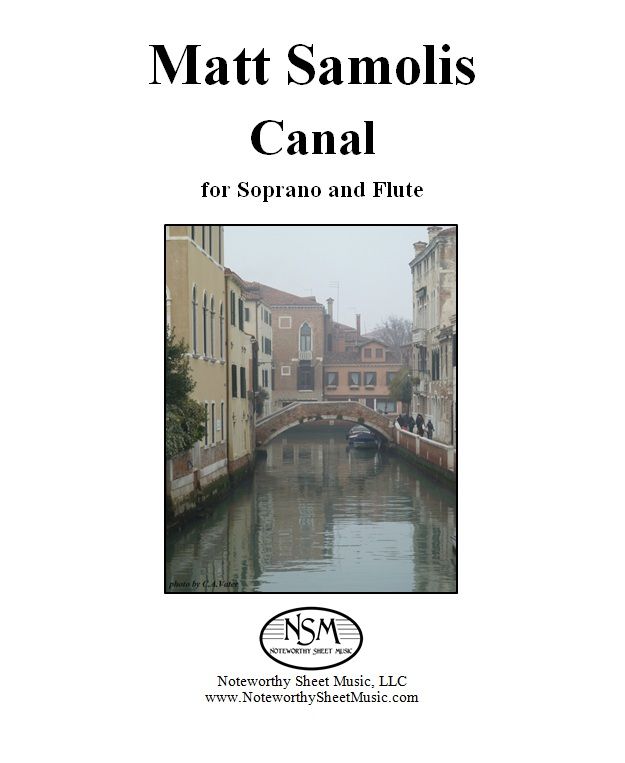 Canal, by Matt Samolis
Canal, by Matt SamolisContemporary Composition for Soprano and Flute, PDF $13.95
Matt Samolis began studying flute, then later composition and tenor banjo. He has worked with ensembles at New England Conservatory, Brandeis University, and Tufts University, as well as Open Hand Theatre, Pilgrim Research Collaborative, and numerous other projects. Currently, his primary focus is composition, curating, and performing as a flutist with various local groups, as well as his drone alliance, The Metal & Glass Ensemble.
Canal is written in a free, self referential style, and uses the text of Roy Campbell's poem of the same name, written in 1920. Despite the somber text, the mood is idyllic and somewhat reminiscent of the contemporary musical language in use at that time. Each player also has a brief ad lib section, where they can interpret the material as they choose.
Click to listen to two snippets of an audio recording of Canal, performed by soprano Noell Dorsey and composer/flutist Matt Samolis:
 Canal Owlseyes
Canal Owlseyes  Canal Whiteflame
Canal WhiteflameOr listen to the full recording on Matt's website.
Score for Soprano and Flute, 5 pages; Total, 7 pages.
Preview==============================================
US customers may purchase professionally-printed hard copies of Canalfrom Noteworthy Sheet Music for $20.93 plus a $5.95 shipping and handling fee. Please use the Contact Us form to let us know which print edition(s) you would like to purchase, along with your contact information and your USPO mailing address.
-
Samolis - Duo for Two Flutes - Flutes
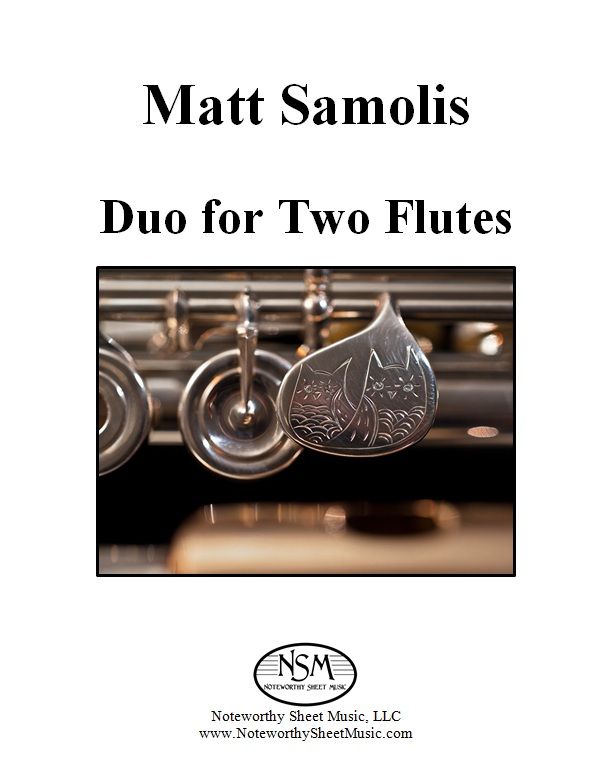 Duo for Two Flutes, by Matt Samolis
Duo for Two Flutes, by Matt SamolisContemporary Composition for Two Flutes, PDF $17.99
Duo for Two Flutes was written using twelve tone techniques. The original tone row was divided in half, with each set of six tones being used to generate one of the flute parts. Frequently changing time signatures reflect compositional organization of the pitches, and does not establish meter. The piece has a playful, somewhat mechanical feel.
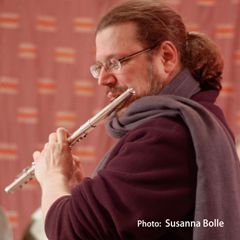 To listen to bits of a recording of Duo for Two Flutes performed by Matt Samolis and Peter H. Bloom, click on the icons below.
To listen to bits of a recording of Duo for Two Flutes performed by Matt Samolis and Peter H. Bloom, click on the icons below.Score for Two Flutes, 8 pages; Total, 11 pages.
Preview -
Sarasate - Romanza Andaluza - Flute
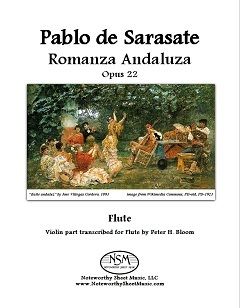 Romanza Andaluza, by Pablo de Sarasate
Romanza Andaluza, by Pablo de SarasateTranscribed for Flute (originally for violin) by Peter H. Bloom
Flute Part, PDF $6.66
'Pablo Sarasate was one of those rare violin virtuosos whose compositions, while designed to display instrumental athleticism, also expressed elegance, economy, imagination, a suave sensuality, and musical integrity. His music befits the sort of technique that, although acrobatic, is captivating rather than assaultive; evocative rather than provocative. It's with this spirit—to amuse, amaze, and engage the audience while providing a satisfying challenge to the performer—that I've adapted his Romanza Andaluza for flute.
Sarasate frequently used the musical material of folk songs and dances from his native Spain as a framework for his pieces. With the melody prescribed, the harmonies implied, and the style both familiar and exotic, he would paraphrase, embellish, and interpret as if to say "with the violin, we can do this..." Inspired by his source material, his methods, and his style, I propose that: With the flute, then, we can do this...' ― Peter H. Bloom, June 23, 2012 ©
Romanza Andaluza, Op.22 was written originally for violin and piano. Editions of the piano score (click to access) are available as free PDF downloads from online libraries of public domain music, such as imslp.org. We provide the Flute part - click below to preview p1.
Flute part, 4 pages; Total, 6 pages.
Preview -
Schnauber - A Little Grand Wedding March Waltz - Piccolo and Trombone
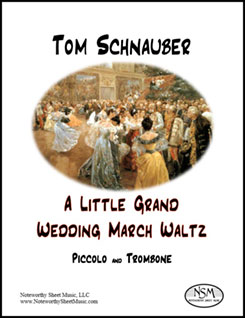 A Little Grand Wedding March Waltz, by Tom Schnauber
A Little Grand Wedding March Waltz, by Tom SchnauberScore for Piccolo and Trombone, PDF $4.99
This piece was written for the wedding of two good friends of mine from graduate school. One was a trombonist and the other a piccolo specialist. It was conceived in the lovely tradition of Hausmusik: short, simple, fun, and meant for two people to play with each other or for friends. Also, though the score indicates trombone and piccolo, it should be equally satisfying with a cello or bassoon on the lower part and a standard flute on the upper. Or even contrabassoon and piccolo . . . whatever you have available. —Tom Schnauber
Score, 3 pages; Total, 4 pages
Preview -
Schnauber - Not-Pooh Songs - Female Voice and Flute or Female Voice and Oboe
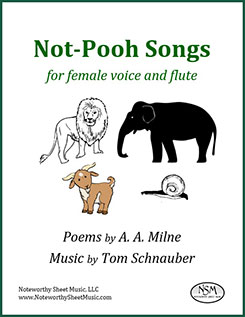 Not-Pooh Songs, by Tom Schnauber
Not-Pooh Songs, by Tom SchnauberFor Female Voice and Flute or Female Voice and Oboe, 2 editions
Score for Female Voice and Flute, PDF $18.46
Score for Female Voice and Oboe, PDF $18.46Tom Schnauber’s Not-Pooh Songs are absolutely delightful. The composer has set to music six children’s poems by A. A. Milne, four from When We Were Very Very Young (“The Alchemist”, “The Mirror”, “The Four Friends”, and “If I Were King”) and two from Now We Are Six ("The Charcoal Burner" and "The Engineer"). The work is offered by Noteworthy Sheet Music, LLC in two publications, one for female voice and flute, the other for female voice and oboe. The oboe line is sufficiently different from the flute line in terms of register to warrant it being published as a separate edition (i.e., the flute version makes use of that instrument’s wider range by putting some material in higher octaves). Also, the flute edition includes an alternate variation of “The Mirror” for voice and alto flute, whereas the oboe edition includes an alternate variation of “The Mirror” for voice and English horn.
It’s clear from hearing this music that Schnauber gets a real kick out of Milne’s poetry. The flute/oboe comments, echoes, etc. go with or against the voice line very effectively and entertainingly. These songs will have broad appeal to both players and audiences, and there’s a lot that a pair of performers could do with them. The music isn’t easy, but provides just the sort of challenges that the adventuresome player loves; in places, for example, the flute jumps from C7 to C4, plays multiphonics, and executes finger snaps. But, as the composer has pointed out, just because the music is somewhat demanding doesn’t mean that it should be presented seriously in performance; on the contrary, players should have fun with these pieces and convey the intended joy and playfulness of the work.
Note that both performers are to play from the score, so flutists and oboists may want to print their copy of the score single-sided to avoid a few difficult page turns.
To listen to a recording of Not-Pooh Songsperformed by Mitsi Westra, voice, and Pamela French, oboe, visit Tom Schnauber’s SoundCloud page at https://soundcloud.com/user-557772917/sets/not-pooh-songs.
► Schnauber - Not-Pooh Songs - Voice and Flute - PDF
 Preview: Not-Pooh Songs for Voice and Flute, p1
Preview: Not-Pooh Songs for Voice and Flute, p1Score for female voice and flute, 22 pages; Lyrics, 2 pages; Total, 28 pages.
► Schnauber - Not-Pooh Songs - Voice and Oboe - PDF
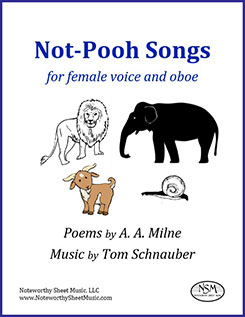 Preview: Not-Pooh Songs for Voice and Oboe, p7
Preview: Not-Pooh Songs for Voice and Oboe, p7 Score for female voice and oboe, 22 pages; Lyrics, 2 pages; Total 28 pages
Front cover images courtesy of Wikipedia.org, Wikimedia.org, and Free Vector Snail Clip Art; Asian Elephant and Lion files are made available under the Creative Commons CC0 1.0 Universal Public Domain Dedication.
- Elephant: author: Shyamal, https://en.m.wikipedia.org/wiki/File:Asian_Elephant_Icon.svg
- Lion: author: openclipart.org, https://commons.wikimedia.org/wiki/File:Lion_clipart.svg
- Goat: released into the public domain by its author, LadyofHats. https://commons.wikimedia.org/wiki/File: Goat_cartoon_04.svg
- Snail: Free Vector Snail Clip Art: Snail Clip Art is a completely free picture material, which can be downloaded and shared unlimitedly.
https://www.seekpng.com/ipng/u2q8y3t4a9e6a9q8_free-vector-snail-clip-art-snail-clip-art/